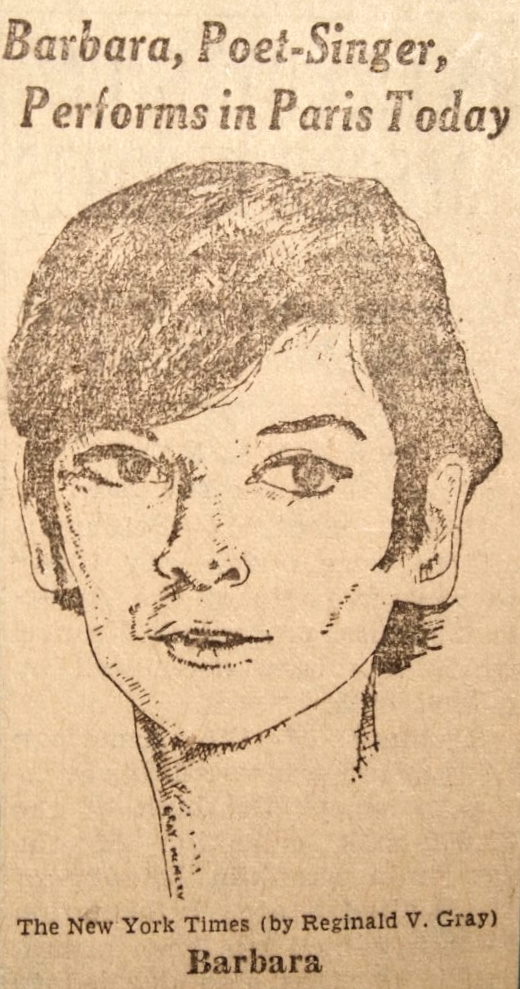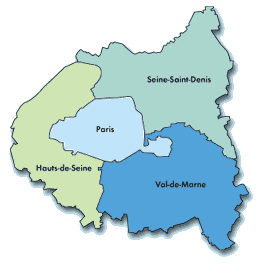|
Barbara (Paris Métro)
Barbara () is a station of the Paris Métro on Line 4 in Montrouge and Bagneux. The station was built as part of a two-station southward extension from Mairie de Montrouge to Bagneux–Lucie Aubrac. It opened in January 2022. History The extension of Line 4 south from Mairie de Montrouge received déclaration d'utilité publique in February 2005. Work to built the extension began in 2015, and was originally planned to open in 2020. During the planning stages of the extension, the station was tentatively called ''Verdun-Sud.'' Following a public vote, the station was named after French singer Barbara, who was buried in the nearby Cimetière parisien de Bagneux. The station was opened on 13 January 2022. The extension is expected to bring 37,000 new passengers per day. The cost of the extension was 406 million euro, split between Ile-de-France Region (60%), the state (25.7%), and the department of Hauts-de-Seine, in which Barbara is located (14.3%). Architecture and des ... [...More Info...] [...Related Items...] OR: [Wikipedia] [Google] [Baidu] |
Paris Métro
The Paris Métro (french: Métro de Paris ; short for Métropolitain ) is a rapid transit system in the Paris metropolitan area, France. A symbol of the city, it is known for its density within the capital's territorial limits, uniform architecture and unique entrances influenced by Art Nouveau. It is mostly underground and long. It has 308 stations, of which 64 have transfers between lines. The Montmartre funicular is considered to be part of the metro system, within which is represented by a 303rd fictive station "Funiculaire". There are 16 lines (with an additional four under construction), numbered 1 to 14, with two lines, 3bis and 7bis, named because they started out as branches of Line 3 and Line 7 respectively. Line 1 and Line 14 are automated. Lines are identified on maps by number and colour, with the direction of travel indicated by the terminus. It is the second busiest metro system in Europe, after the Moscow Metro, more than two and a half times London U ... [...More Info...] [...Related Items...] OR: [Wikipedia] [Google] [Baidu] |
Barbara (singer)
Monique Andrée Serf (9 June 1930 – 24 November 1997), known as Barbara, was a French singer. She took her stage name from her grandmother, Varvara Brodsky, a native of Odessa, Russian Empire (now Ukraine). Barbara became a famous cabaretière in the late 1950s in Paris, known as ('the midnight singer'), before she started composing her own tracks, which brought her to fame. Her most famous songs include "Dis, quand reviendras-tu ?" (1962), "Ma plus belle histoire d'amour" (1966) and "L'Aigle noir" (1970), the latter of which sold over 1 million copies in just twelve hours. She was buried at the Cimetière parisien de Bagneux, adjacent to the Paris Métro station named in her honour. The station ''Barbara'' opened 13 January 2022, on a southern extension of Line 4. Childhood Born on Rue Brochant in Paris to a Jewish family, Barbara lived in northwestern Paris as a child. She then lived in Roanne from 1938 and Tarbes from 1941. Barbara was 13 years old when she had to go i ... [...More Info...] [...Related Items...] OR: [Wikipedia] [Google] [Baidu] |
Paris Métro Stations In Montrouge
Paris () is the capital and most populous city of France, with an estimated population of 2,165,423 residents in 2019 in an area of more than 105 km² (41 sq mi), making it the 30th most densely populated city in the world in 2020. Since the 17th century, Paris has been one of the world's major centres of finance, diplomacy, commerce, fashion, gastronomy, and science. For its leading role in the arts and sciences, as well as its very early system of street lighting, in the 19th century it became known as "the City of Light". Like London, prior to the Second World War, it was also sometimes called the capital of the world. The City of Paris is the centre of the Île-de-France region, or Paris Region, with an estimated population of 12,262,544 in 2019, or about 19% of the population of France, making the region France's primate city. The Paris Region had a GDP of €739 billion ($743 billion) in 2019, which is the highest in Europe. According to the Economist Intelli ... [...More Info...] [...Related Items...] OR: [Wikipedia] [Google] [Baidu] |
Paris Métro Stations In Bagneux
Paris () is the capital and most populous city of France, with an estimated population of 2,165,423 residents in 2019 in an area of more than 105 km² (41 sq mi), making it the 30th most densely populated city in the world in 2020. Since the 17th century, Paris has been one of the world's major centres of finance, diplomacy, commerce, fashion, gastronomy, and science. For its leading role in the arts and sciences, as well as its very early system of street lighting, in the 19th century it became known as "the City of Light". Like London, prior to the Second World War, it was also sometimes called the capital of the world. The City of Paris is the centre of the Île-de-France region, or Paris Region, with an estimated population of 12,262,544 in 2019, or about 19% of the population of France, making the region France's primate city. The Paris Region had a GDP of €739 billion ($743 billion) in 2019, which is the highest in Europe. According to the Economist Intelli ... [...More Info...] [...Related Items...] OR: [Wikipedia] [Google] [Baidu] |
Platform Screen Doors
Platform screen doors (PSDs), also known as platform edge doors (PEDs), are used at some train, rapid transit and people mover stations to separate the platform from train tracks, as well as on some bus rapid transit, tram and light rail systems. Primarily used for passenger safety, they are a relatively new addition to many metro systems around the world, some having been retrofitted to established systems. They are widely used in newer Asian and European metro systems, and Latin American bus rapid transit systems. History The idea for platform edge doors dates as early as 1908, when Charles S. Shute of Boston was granted a patent for "Safety fence and gate for railway-platforms". The invention consisted of "a fence for railway platform edges", composed of a series of pickets bolted to the platform edge, and vertically movable pickets that could retract into a platform edge when there was a train in the station. In 1917, Carl Albert West was granted a patent for "Gate for ... [...More Info...] [...Related Items...] OR: [Wikipedia] [Google] [Baidu] |
Hauts-de-Seine
Hauts-de-Seine (; ) is a département in the Île-de-France region, Northern France. It covers Paris's western inner suburbs. It is bordered by Paris, Seine-Saint-Denis and Val-de-Marne to the east, Val-d'Oise to the north, Yvelines to the west and Essonne to the south. With a population of 1,624,357 (as of 2019)Populations légales 2019: 92 Hauts-de-Seine INSEE and a total area of 176 square kilometres (68 square miles), it is the second most highly densely populated department of France after Paris. It is the [...More Info...] [...Related Items...] OR: [Wikipedia] [Google] [Baidu] |
Cimetière Parisien De Bagneux
Cimetière parisien de Bagneux is one of the three Parisien cemeteries ''extra muros'', located in Bagneux. The cemetery has a large Jewish section (many of the divisions have exclusively Jewish graves) and is sometimes known as the '' Jewish cemetery''. History Before the site became a cemetery, it was the scene of heavy fighting in May 1871, in the war between the Versailles and the Fédérés. The cemetery was opened on 15 November 1886 and is one of the three Parisien Cemeteries ''extra muros'', the others being Cimetière Parisien de Thiais (opened in 1929) and Cimetière Parisien de Pantin. It was opened at the same time as Pantin, (which is northeast of Paris). Both have similar entrances. Bagneux is the smallest of the three cemeteries serving Paris, but the most active. Notes The cemetery is still open and there are about 10 burials a day. The cemetery is divided into 115 divisions. It is estimated that there are around 83,000 graves. The cemetery was the burial pla ... [...More Info...] [...Related Items...] OR: [Wikipedia] [Google] [Baidu] |
Déclaration D'utilité Publique
A ''déclaration d'utilité publique'', or declaration of public utility, is a formal recognition in French law that a proposed project has public benefits. The declaration must be obtained for many large construction projects in France, especially for infrastructure, before work can begin. Process The first part of the declaration is a public inquiry, usually started by a prefect, to collect the views of all affected parties. Responses from affected parties are considered by a commissioner, who assesses whether the proposal has an overall benefit for the public. If the finding is favourable, the declaration is granted by decree. Legal basis The ''déclaration d'utilité publique'' was initially required by article 545 of the Civil Code, which stipulates that property cannot be confiscated except for public purposes and with fair compensation. See also * Eminent domain Eminent domain (United States, Philippines), land acquisition (India, Malaysia, Singapore), compulsory purchase ... [...More Info...] [...Related Items...] OR: [Wikipedia] [Google] [Baidu] |
Finn Geipel
Finn Geipel (born 23 November 1958 in Stuttgart) is a German Architect and Urbanist. He is co-founder of the architecture and urban planning office LIN.Joseph Hanimann: ''Finn Geipel' Stand: 3. Dezember 2012 Life Geipel studied architecture from 1981 to 1987 at the University of Stuttgart. In 1983, together with Bernd Hoge and Jochen Hunger, he founded Labfac, Laboratory for Architecture, a network of architects and artists. In 1987, collaboration with Nicolas Michelin began a new chapter of Labfac in Paris. In 2001, Finn Geipel and Giulia Andi founded the architecture and urban planning office LIN. Based in Berlin and Paris, the office works on a wide range of projects and research assignments throughout Europe. Recent projects include the renovation of Saint-Nazaire submarine bunker, the Cité du Design in St. Etienne and Grand Paris Métropole Douce. Finn Geipel is a full-time professor of architecture and building science in the architecture department at Berlin Institute ... [...More Info...] [...Related Items...] OR: [Wikipedia] [Google] [Baidu] |
Groupe RATP
A group is a military unit or a Formation (military), military formation that is most often associated with military aviation. Air and aviation groups The terms group and wing (military aviation unit), wing differ significantly from one country to another, as well as between different branches of a national defence force. Air groups vary considerably in size and status, but generally take two forms: * A unit of two to four Squadron (aviation), squadrons, commanded by a lieutenant colonel, colonel, commander (rank), commander, Captain (naval), naval captain or an equivalent rank. The United States Air Force (USAF), ''groupes'' of the French ''Armée de l'air'', ''gruppen'' of the German ''Luftwaffe'', United States Marine Corps Aviation, British Fleet Air Arm and some other naval air services usually follow this pattern. * A larger formation, often comprising more than 10 squadrons, commanded by a major general, brigadier general, Commodore (rank), commodore, rear admiral, air ... [...More Info...] [...Related Items...] OR: [Wikipedia] [Google] [Baidu] |





